-
Car Reviews
- All reviews
- Midsize SUVs
- Small cars
- Utes
- Small SUVs
- Large SUVs
- Large cars
- Sports SUVs
- Sports cars
- Vans
Latest reviews
- Car News
-
Car Comparisons
Latest comparisons
- Chasing Deals
The Mercedes-Benz Driving Academy, the training offshoot of the German manufacturer, is one of a crop of driving experience programmes launched in recent years by premium car brands. Along with BMW’s Driving Experience and Audi’s Advanced, Performance, and Race Driving Experience, the Mercedes Academy seeks to fulfil a number of aims. On the surface, the Mercedes Driving Academy exists to give owners the chance to hone their knowledge of the driving safety features across the current range. On a secondary level, though, the Driving Academy is an elaborate marketing exercise. By letting its customers loose in a range of Benzes in a racetrack environment, Mercedes adds an additional dimension to the after-sales experience, and with it, the likelihood of triggering a repeat purchase.
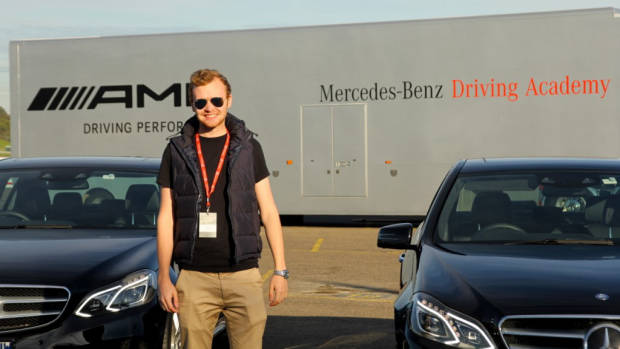
Chasing Cars attended the autumn Mercedes-Benz Driving Academy at the Sydney Motorsport Park raceway at Eastern Creek. The wider programme is international, with events of various calibre occurring throughout the world. Winter driving experiences are largely confined to the Northern Territory, with ice driving offered in Scandinavia and mountainous training in Germany; however, in moderate climate environments like ours, the Driving Academy is split into three levels:
We experienced the regular Driving Academy programme, which Mercedes-Benz brands as a drive day, rather than a race day. That’s due to an emphasis on safety feature demonstrations, particularly earlier-on in the day. It’s not to say, though, that you don’t experience serious speeds. The day included a shotgun ride in the superseded C63 AMG where we recorded 240km/h; under our control in vehicles like the SL63 AMG we saw more than 200km/h. While the Driving Academy isn’t explicitly about performance, it still includes just enough speed to keep things interesting.
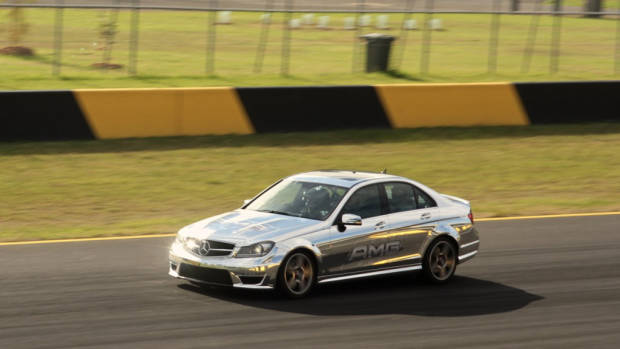
The session lasts about four hours, and commences with a thorough briefing on the cars and the safety features that will be experienced throughout the morning. Mercedes-Benz have assembled an experienced group of trainers that rotate around various Australian locations, all of whom held racing qualifications, and many of whom are current Formula 3 (or equivalent) racers. With the theoretical training out of the way after about half an hour, participants are split into small groups—typically one trainer to every two participants, which Mercedes say is a much smaller ratio than what their competitors offer.
Groups are able to put in preferences for the vehicles they would like to be based in, though the staff are happy to accommodate requests to drive any of the vehicles offered throughout the day.
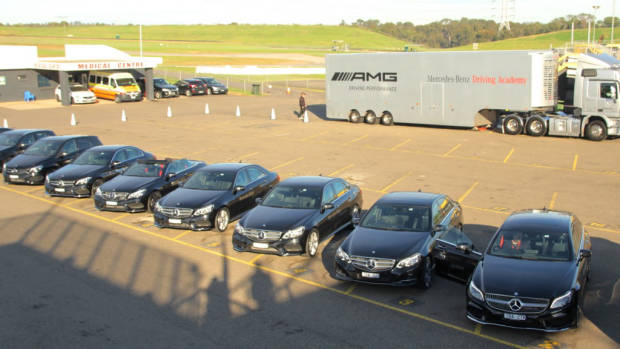
We selected the C200 Bluetec as our base vehicle. At that point, it was time to get started with five familiarisation laps of Eastern Creek, which included access to the new International–Brabham section of the track, offering up some tighter, faster corners towards the park’s back-end.
The Driving Academy session is anchored in a number of impressive safety demonstrations, interspersed with laps around the track when the demonstrations are occupied by other groups.
All of the demos are focussed on the participants, and are designed to improve driving skills in concert with learning more about how the safety features in modern Benzes work to help the driver.
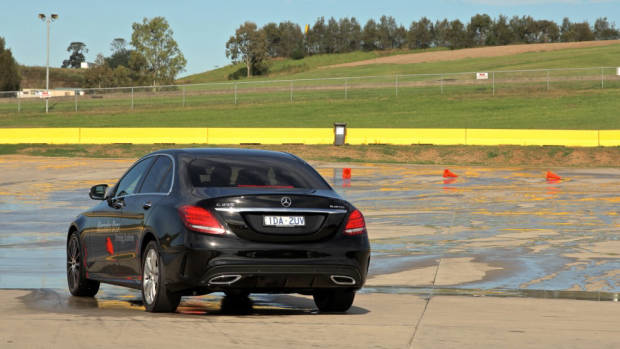
First up for us was a braking demonstration, consisting of emergency stops from 110km/h out on the track. Mercedes are keen to demonstrate the brake assistance systems when you throw out the anchors. The vehicle can detect when you want 100% pressure and help you achieve it—the company quotes timidity with the brake pedal as a big problem in accidents. Additionally, the cars articulate individual brakes to achieve near dead-straight stops.
Braking training was followed by arguably the best fun of the day—traction control training on the wet skid pan, in a turbodiesel C250 Bluetec. Plastic-lined rear tyres had been fitted to the C-Class to provide ice-like tractability in an attempt to recreate the northern Europe training environment, and to great success—with the vehicle’s traction control systems turned off, bringing the drifting, rear-drive C250 under control was a hilarious challenge. Just as impressive as when the traction was turned back on, having the vehicle step out was almost impossible.
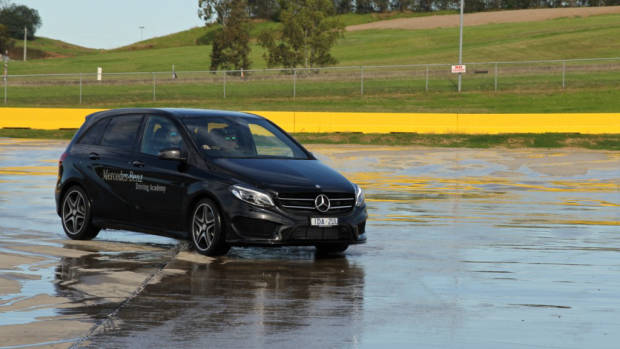
Staying on the skid pan, we shifted across to a B250 for a swerve-and-stop challenge combined with reaction training. This consisted of flooring the car towards a set of bi-directional lights. If the left-hand light lit up, that indicated a swerve to the left while also braking hard to avoid the theoretical obstacle in our ‘lane’. This is a skill that Australian drivers rarely get a chance to master in a controlled environment, and given the amount of highway driving many in our country do, it’s something we could all benefit from. The usefulness for avoiding a stray kangaroo or vehicle that loses control ahead is obvious.
Outside of the safety exercises, plenty of time is also allocated for controlled track driving. The instructors sit in the passenger seat at all times, but participants are able to select a vehicle from the lineup to take for a few laps around the track. We were surprised by how liberal Mercedes is with allowing freedom of choice among the cars: we were able to do a few hot laps—at properly rapid speeds—in the $429,000 S63 AMG. Now that’s a properly unique experience.
For existing customers considering purchasing a new Mercedes, the Driving Academy offers an interesting alternative to the test drive. Not every car is represented at the track, but most are—we individually sampled the A-Class, B-Class, C-Class, E-Class, S-Class, SL-Class—not to mention the Actros truck—at various points throughout the morning. Given the high-pace nature of the Eastern Creek track and the keenness of the instructors to get you to experience high speeds, it’s a great way to push the cars to the limit in a safe environment.
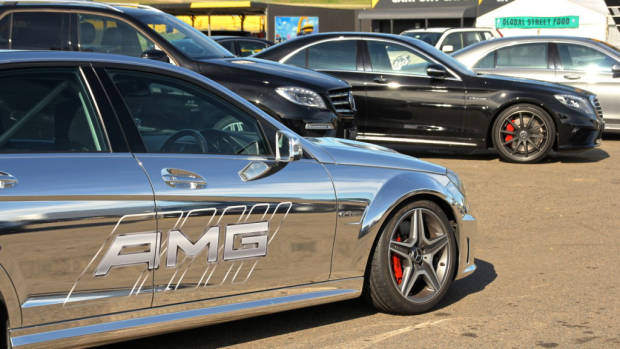
Driver training in Australia is an ongoing concern: the provisional licence test is the only time driving skills are practically assessed by any official body. Drive on our roads and there are plenty of examples of limited skill: right-lane hoggers, those driving too fast or too slow for the conditions, and poorly-timed manoeuvres are just some of the examples.
Programmes like the Mercedes-Benz Driving Academy are useful because they have a role in breaking a number of the bad habits that develop in countries like Australia where ongoing driver learning is not a requirement. We’d recommend undertaking driver training, whether it’s in a manufacturer programme like this one, or a private experience, as it’s a great way to quickly add to your foundation of driving skills that keep all of us safe out on the road.
Latest news
About Chasing cars
Chasing Cars reviews are 100% independent.
Because we are powered by Budget Direct Insurance, we don’t receive advertising or sales revenue from car manufacturers.
We’re truly independent – giving you Australia’s best car reviews.